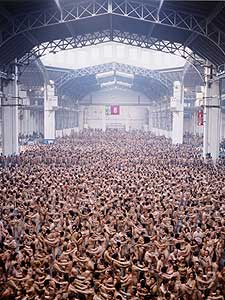|
Audio
Photos
More from MPR
|
January 28, 2005
Group pictures are probably the most ubiquitous form of photography around. We take them mainly for commemorative rather than artistic reasons. "Rite of Assembly," a new exhibition at the Weinstein Gallery in Minneapolis, explores the roots and evolution of group photography as an artistic genre.
Minneapolis, Minn. — Taking a group shot is a snap. Most people don't put a lot of thought into it.
Shutter clicks, end of story, right? But some people see an opportunity to create art, because as photographer Neal Slavin puts it.
"There's something that happens when people come together."
Slavin is known throughout the world for his oversized color group portraits. He's published two popular books of pictures, and his work regularly appears in Rolling Stone, and the New York Times and Washington Post magazines.
We're standing in front of a four by five foot photo of Slavin's, entitled "DC Fencers." It features a Washington D.C. fencing club making mayhem in a fancy hotel ballroom. White cloth covered tables are tipped over as about 20 fencers in white uniforms lunge, parry and retreat in chaotic fashion. Slavin says he set up and lit the picture then asked the fencers to get crazy.
"And it was a blast," he says. "The only thing they had to watch was that there was a frame line, so that they wouldn't be out of frame. Then they just went to town and I just kept shooting. And that's it. This whole picture took about two hours to do."
Some describe Slavin's work as performed group photography. He's like a photographic choreographer, but he prefers that his subjects be his artistic partners. Slavin often lets the people in the picture determine where they'll be.
"Not only that," he says. "What I do is I show them a polaroid. I say 'Well, what do you think?' 'Well, that's kind of great, but if Joe could be here.....' And they'll improve the picture. And even if they don't improve it, it's an inner document of who they are."
Slavin says he became addicted to group photography because of its layers of expression, and its potential for humor. Slavin says you know how some people like to lose themselves in a road map? Group pictures have the same effect.
"You look at a face, and he's looking out that way, and the person next to him is looking this way," he says. "And suddenly you say to yourself, 'What are they really like?' Were they not talking to each other? They're five miles apart. And this is a small dot, and that's a little bigger city. She's a little bigger. And you start connecting the roads from all those people."
Slavin is one of eight photographers featured in "Rite of Assembly."
Spencer Tunick, who's known for photographing large groups of naked people in public places, has work in the show. So does Minneapolis photographer Paul Shambroom, who's gained fame for his pictures documenting hundreds of municipal meetings around the country.
There's also one photograph from what many call the grandfathers of performed group photography, Arthur Mole and John Thomas. It was taken in 1917, and shows hundreds of soldiers in a human formation of the American flag. Martin Weinstein is owner of the Weinstein Gallery. He says Mole and Thomas specialized in using sometimes tens of thousands of military personnel to create human sculptures of patriotic images, which they photographed from atop an 80-foot tower.
"I always thought they were the greatest performance artists who have ever lived," he says. "Perhaps some of the greatest artists who ever lived."
Weinstein says Rite of Assembly is designed to bring attention to some incredibly talented artists who labor in an under appreciated genre. He thinks they go way beyond photo journalism.
On the more pedestrian level of group photography, there are still millions of us out there taking uninspired pictures. But Neal Slavin shys away from answering the question, 'How do we make them better?'
"It's such a hard question," he says. "It's like when somebody says to you, how do you make a photograph?"
The answer to that question, to some extent, is on the walls of the Weinstein Gallery trough March 12th.







